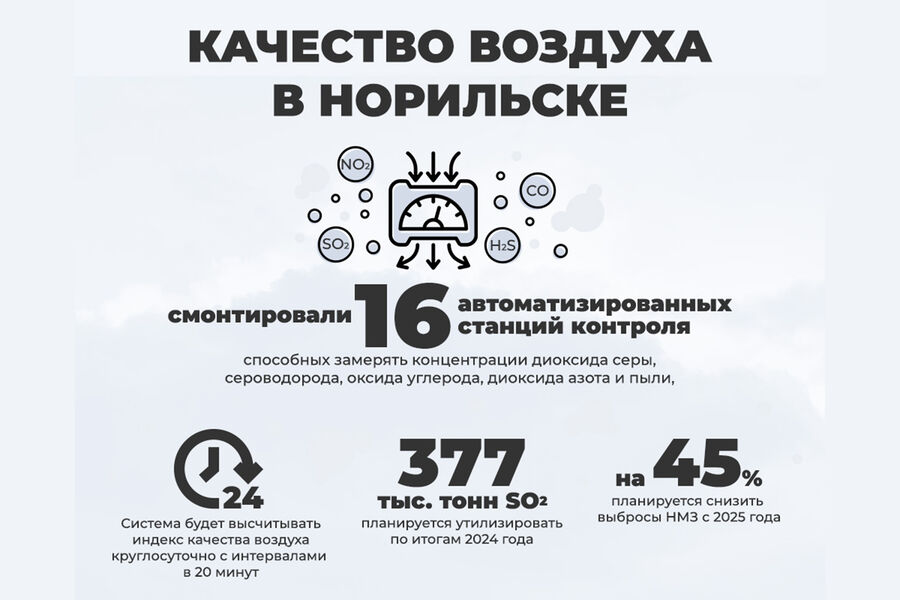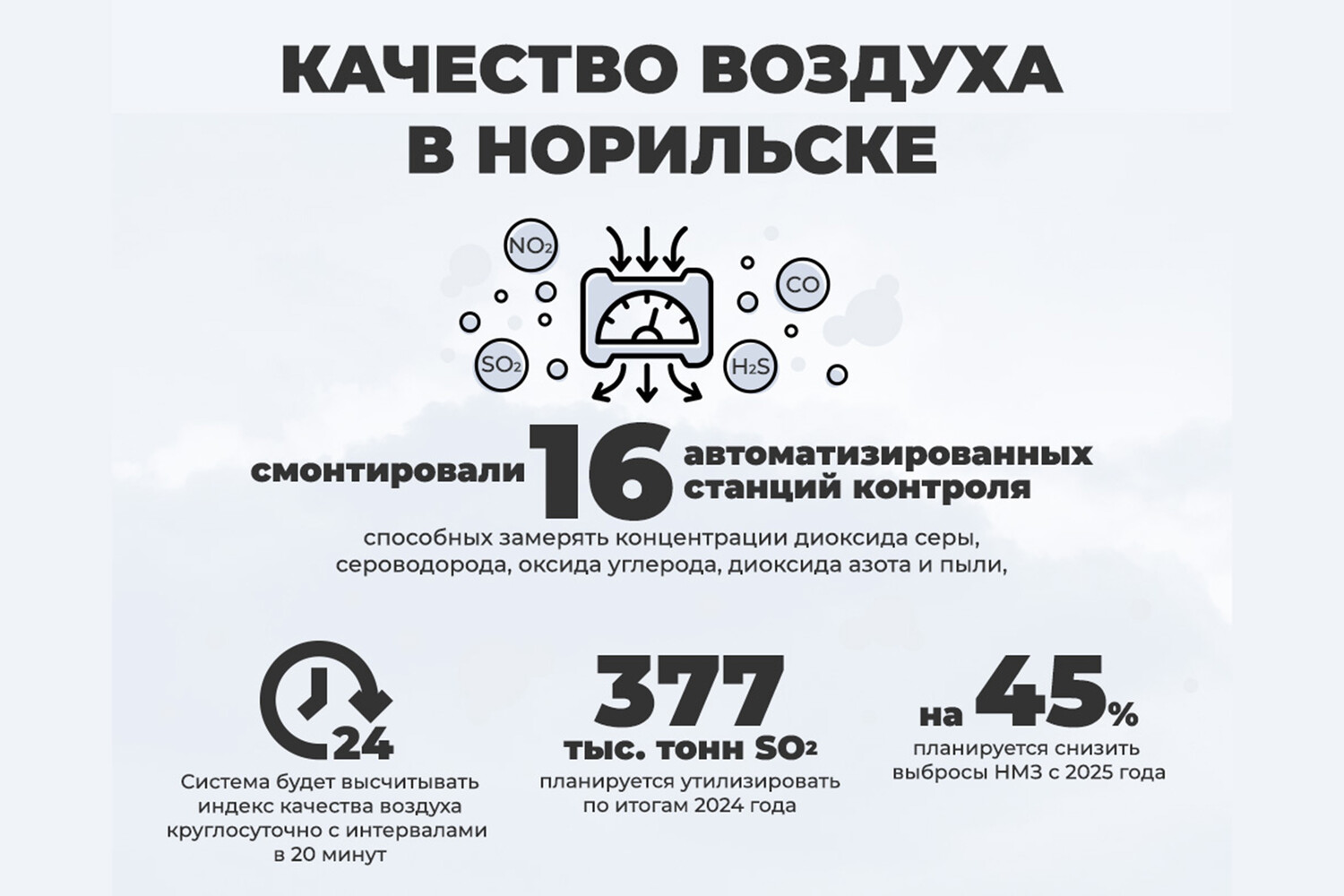Norilsk Nickel has launched an online monitoring system for the state of atmospheric air in residential areas of Greater Norilsk. In addition to the “historical” center, it also operates in Talnakh and Kayerkan districts. Sensors and devices capable of measuring sulfur dioxide, hydrogen sulfide, carbon monoxide, nitrogen dioxide and dust concentrations were installed at 16 automatic monitoring stations. The system will calculate an air quality index around the clock, in 20-minute intervals, which is intuitive even for ordinary people. “Green” color means there is no pollution, “yellow” means it is at a moderate level, and “red” means precautions need to be taken.
In 2021, Norilsk Nickel enterprises became participants in a pilot project to implement automatic control systems for the state of atmospheric air in industrial cities in Russia, as envisaged by the Ecology national project. Similar monitoring is already in operation in some other cities participating in the Federal Clean Air project – in Lipetsk from NLMK, in Magnitogorsk from MMK and in Cherepovets from Severstal, information on monitoring is published on the company’s websites. But Norilsk Nickel took a different path – a public interface was launched on the official website of the city administration, Norilsk.rf. And the company donated the system to the Norilsk administration free of charge.
“The main consumers of the system are residents of Norilsk; It was created for them in the first place. Every resident of Norilsk will be able to receive objective information about how clean the air is at any time. Thus, Norilsk Nickel, the city-forming enterprise of Norilsk, demonstrates openness,” the company emphasizes.


Press service of Norilsk Nickel
get rid of sulfur
Norilsk Nickel added that thanks to the new public monitoring system, “it will be possible to observe with your own eyes that the city will cease to be a leader in air pollution ratings.” The company is implementing the “Sulfur Program” to get out of these “black lists” forever. The largest part of the Federal Clean Air project is aimed at reducing sulfur dioxide emissions in Norilsk.
The company put into operation the first technological line of the complex for the use of this gas at the end of last year, connected to the Nadezhda Metallurgical Plant, investing more than 180 billion rubles in a unique construction project on a global scale. In the autumn of this year, the second line was commissioned at NMZ and another replacement line was tested. The first results are impressive: it is planned to use 377 thousand tons of sulfur dioxide by the end of 2024 and to reduce emissions from NMZ by 45% from 2025.
“It will be interesting to observe changes in the volume of sulfur dioxide emissions in Norilsk during the installation of a huge facility being built to capture this harmful substance. In this context, the emergence of modern institutional monitoring systems in Russia’s industrial centers, especially those that provide open data, can be welcomed. In fact, such innovations are even more valuable for the conditions of the Arctic, where there is almost nothing other than man-made influences (few people and vehicles),” he told PORA.
A bold experiment
However, he emphasizes that Norilsk Nickel’s “ecological exposure” not only to the state, which has already received all data on emissions from enterprises, but also to the residents of the entire city is a unique situation in Russian corporate practices. Platform center, Alexey Firsov.
“Some large companies in other regions also planned to implement such projects, but eventually gave up. Anything can happen in production; No one is safe from accidents anywhere. And to voluntarily put ourselves in a situation where constantly attracting public attention, where any city dweller can observe fluctuations in the environmental situation in real time, is still a kind of challenge for our work. The sociologist noted that you need a pretty high level of clarity to decide this.
Firsov reminds that Norilsk is ideal for “urban” online monitoring, because in this city the only air polluter is also the only one. Everything is very clear regarding the main pollutant. In other industrial cities it may be almost impossible to determine an equally clear “center of responsibility”, and the atmospheric “bouquets” there are more diverse.
He also believes that the Norilsk Nickel case can also be called a bold social experiment: “On the one hand, this creates a new point of vulnerability for situations where some excesses will occur, especially unpleasant odors. “On the other hand, online monitoring will help to slowly start to work through persistent stereotypes that ‘our city is dirty’ and nothing has changed about it.”
important step
According to NM, city council aide and associate professor of ecology at Polar State University. From Fedorovsky to Natalya Karmanovskaya, Norilsk Nickel gives all Norilsk residents “the opportunity to exercise the right to reliable and complete information about air quality, as provided for in the Constitution of the Russian Federation, which has never happened before in this region.”
“This is an excellent step that demonstrates the company’s high level of openness and confidence in improving the situation in the near future. Thanks to the implementation of the Sulfur Program and other activities, we will all now be able to observe the major changes that have already occurred in the ecology of the city,” the expert said.
Alexey Knizhnikov, an expert on environmental responsibility of business at the Foundation for Nature and People, believes that open access to air quality monitoring is important and necessary wherever air pollution problems are increasing. The expert recalled that due to the lack of access to data from official (state) systems, civil networks have also been actively developing in cities in recent years – residents themselves buy sensors and exchange data.
“Institutional monitoring systems can and should make a significant contribution to solving the problem of access to data on air pollution levels, which is especially important for local people. The success of such projects will also depend on the periodic independent verification of these institutional data, always with the participation of local community representatives,” Knizhnikov concluded.
What are you thinking?
Source: Gazeta
Ben Stock is a business analyst and writer for “Social Bites”. He offers insightful articles on the latest business news and developments, providing readers with a comprehensive understanding of the business world.

